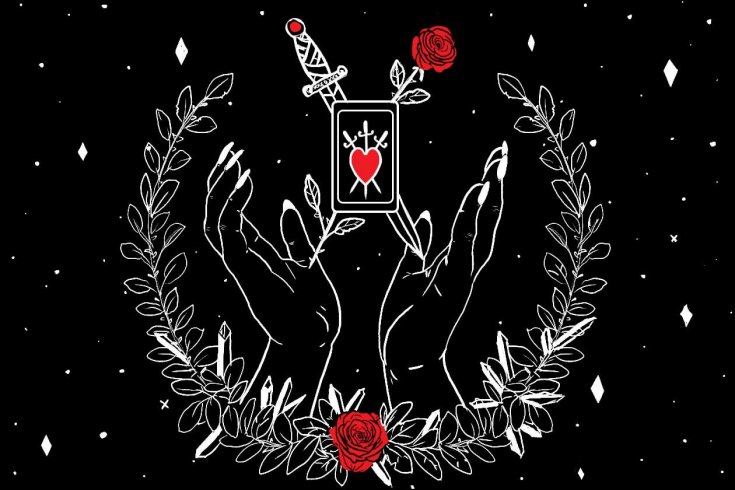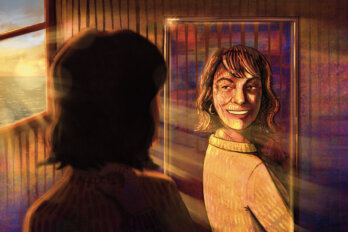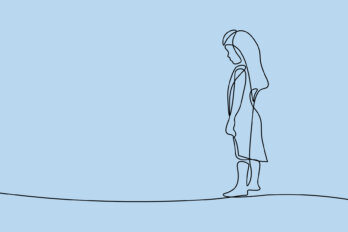It’s January 2017 and I’m inside a community centre, standing poolside, wearing bathing suit bottoms and nothing else. A middle-aged woman waves her hands up and down in front of me, as if finger combing an invisible head of hair. I’m told she is purifying my energy, a necessity if I’m to partake in this year’s Imbolc ritual, a ceremony meant to honour the Celtic goddess Brigid and welcome the coming of spring. Imbolc is a celebratory occasion for witches, perhaps the magical equivalent of Groundhog Day—just swap the rodents for some candles, singing, and bare breasts.
I try to adopt an “earth child” state of mind because a) this might be the only way to conceptualize my half-naked body as a product of nature and not a shameful blob of flesh and b) earth children are more likely to see the concept of energy purification as real and desirable, not hippy-dippy nonsense. The truth is, I also desperately want this ritual to feel legitimate, because it’s tied to a group of people whom I’ve grown to respect and trust. The witches I’ve spoken with over the past few months are environmentalists, feminists, political activists, and animal lovers. They are good people. But today is the first time I’m seeing their spirituality in practice. I don’t want to see them reduced to amusing characters, which is my fear if this is all too kooky. I feel like I’m at the poetry reading of a new love interest: come on, please be good.
I make my way over to the hot tub with the other participants—about a dozen women and three men. Nakedness surrounds me, but I’m starting to feel desensitized to it already. In this setting, flesh is not tantalizing or sexual or forbidden. It feels normal, and so when I light my candle and lower myself into the warm water, I want nothing to do with my bathing suit bottoms anymore, which feel clingy and pointless. I take them off, scrunch them into a sopping ball and place them on the edge of the hot tub. Sitting back down, I feel the grainy concrete beneath my butt cheeks and it feels…right? Maybe this is a promising start to learning more about witchcraft—to seeing if I, too, could be a witch. If I could believe what these women believe.
My initial interest in witchcraft started after a conversation I had with a friend who said, in reference to a writer I admired, “Oh, yep, she’s a witch.” She said it so casually, as if mentioning this woman’s vegetarianism or plans to go to law school. And yet, witchcraft has long been a contested, even maligned, religion. Traditionally, witchcraft is drawn from paganism, an umbrella term for spiritualities that posit nature as the ultimate divine while acknowledging a multiplicity of gods and goddesses. Despite its benign-sounding origins, however, the history of witchcraft is also closely associated with women and the idea of control—whether that means breaking free or binding. Witch hysteria hit Europe around the fourteenth century, and since then, the term “witch” has been used as a way to cast suspicion on women who eschew the perceived status quo. Throughout its history, the label has implied a variety of malevolent misdeeds designed to put women back in their so-called place: cavorting with the devil, devouring children, hexing enemies, acting like an “old hag,” or, more topically, like a “nasty woman.”
Recently, witchcraft has seen a modern revival of sorts, particularly among liberal-minded millennials who want a more spiritual brand of girl power. This rise can, in part, be linked to the aesthetics of present-day witchcraft. That is, a crystal-laden, velvet-draped vibe that is ready-made for our lifestyle-centric Instagram era—one in which how you look doing something matters as much, or more, as actually doing it. The trend goes both high and low: tarot cards can now be purchased at Urban Outfitters; Gucci’s spring 2017 collection featured embroidery based a type of tarot card; fashion website Revelist saw fit to review Witch Worldwide, a clothing brand for “witchy goths of all sizes.” As far as religions go, witchcraft simply looks like a millennial lifestyle brand—or, at least, more so than most others.
And yet, that is only a part of it. Beyond fashion, contemporary witchcraft’s brand of political self-care gives feminists a framework for both achieving personal empowerment and fighting the patriarchy (and that’s particularly true of those who converse on the internet). If the idea of witches has traditionally shape-shifted to feed society’s fantasies of women and their roles, then today’s witches are starting to subvert the stereotypes, this time creating their own, new fantasy—that of a strong, empowered, cool woman. Go-to pop feminism sites like Lenny Letter and Broadly regularly post horoscopes that say things like: “Let nothing shame you into submission. Let nothing seduce you into conformity. Let nothing curb your care for what means the most to you.” There was even a mass spell cast on Trump following the election: #bindTrump went viral, receiving public support from musician Lana Del Rey and media attention from BuzzFeed and the BBC. It’s as much about believing the world can be a better place as it is about believing in ourselves.
One of the first real witches I meet is Mandy Banks, a cultural studies professor at a northwestern university who has studied witches from a historical perspective. Smooth stones and crystals glitter atop her desk; an astrological calendar (complete with a winged purple horse) hangs from the wall; she’s wearing a necklace with a strawberry-sized hunk of quartz. “My interest first sparked when I lived in Sweden,” she tells me. “I was surrounded by old Viking culture, rune stones, a lot of reminders of ancient, pre-Christian times. From there, I started reading books and looking into the topic. Now I practice witchcraft all the time and every day.”
For Banks, magic follows a similar principle to the law of attraction—if you build it, they will come, etc.—where crystals, altars, and ritual are tools for concentration and self-awareness. Spells and rituals might be to witchcraft as meditation is to Buddhism, yet the former remains stigmatized in a way the latter isn’t, which is why Banks (who’s name isn’t actually Mandy Banks) is still in the broom closet. And this is where the trend gets complicated: being witchy on Instagram, or in feminist-centred spaces, is not only accepted but even cool; being an actual witch within, say, the traditional halls of academia or other industries, such as finance and business, may be detrimental. Whereas society has widely recognized the legitimacy of certain mainstream religious practices, such as prayer and fasting, the idea of spells is still dismissed as eye-roll worthy at best and whacky at worst. Going to church is one thing, but dancing naked in the night is seen as the realm of Hollywood movies or lonely teenagers who wear too much black eyeliner. In other words, despite its status as a religion and its rising place in pop culture, witchcraft still struggles on the fringes of real belief—not unlike many women-led movements.
“I don’t want to be named, because people who aren’t knowledgeable about witchcraft, like actual witchcraft, associate the term with negative things,” Banks says. She doesn’t want to be seen as a “sex vampire” or an “old crone,” two unflattering images often associated with witches. Her academic career is still in its infancy; for future jobs, it’s important her name stay free of labels that translate as unprofessional or freaky. “I don’t bring in anything that’s too obviously magical,” she says. “And most people are ignorant of the symbolism.”
And yet there is a place where her witchcraft converges with our modern desire to believe—to step outside the boundaries of our traditional roles and religions. In practice, Banks tells me, witchcraft involves a lot of singing, building altars, and praying—all of it on her own terms and none of it prescribed to her by an organization or institution. This is what she loves about witchcraft: it’s completely customizable and resists the idea that there is one all-powerful male deity. Witchcraft, she says, is about seeing “the divine” in everything—people, plants, that piece of gum on the sidewalk—and recognizing women as powerful. “You can pray to whoever you want, and no one can tell you it’s wrong,” she says, citing Stevie Nicks as a go-to worship figure for the musically inclined. “There’s speculation that Stevie herself is a witch,” she adds.
Where people often get stuck, of course, is the magic. “Spells work,” says Banks, quick to cite her own evidence. She tells me of a Sunday in August 2014 when, beneath the full moon, she focused her intention on getting a job, a promotion, and financial stability for the next year. She wrote her wishes on paper and burned them, releasing the ashes to the earth, which digests the cinders in soil; the air, which cradles them in its breeze; the water, which swallows the black dust in its midnight wake. She planted her intentions in the universe then waited for them to grow. They did. Banks got all three of her wishes, but she clarifies that spells are, first and foremost, about personal clarity. “You have to put work into them. Spells are more about changing you so that the world changes in the way you want.”
Many witches today believe that, as human beings, it is our responsibility to re-establish and foster a connection with the planet, those who inhabit it, and our histories. Justine Little, who is a witch and a political activist within the Vancouver LGBTQ community, says the witches in her circle are working towards making colonial reparations. “We are trying to repair relationships with Indigenous communities in the Coast Salish territories and make the community safer and healthier for Indigenous community members,” says Little. “That means educating ourselves on how to properly ask permission from the nations whose land we hold events on and actively reflecting and taking steps to address cultural appropriation within our spiritual community.”
As an example, this Samhain—the witch’s new year and a popular time for group rituals that takes place on the last day of October (i.e., Halloween)—Little and her fellow witches will be donating funds to Unist’ot’en Camp, which is an Indigenous reoccupation effort to stop pipeline production through traditional Wet’suwet’en lands in northern BC. Little’s group is doing what it can to make the world a better place and, despite the witchy date they are choosing to celebrate on, is not unlike many other religious groups who are also driven by social consciousness to acts of charity. Perhaps this is the point: witchcraft, like any other religion, attracts people who are looking for answers and purpose, particularly during troubled times.
Casting a spell to impede pipeline progress may be the modern equivalent of a prayer for rain, but political activism, although common these days, is not a prerequisite for witches. In fact, there is only one basic rule, called the Wiccan Rede: if it harms none, do what ye will. This means that, as a witch, you’re free to practice your own form of magic in whatever way you please and toward whatever goal (stopping pipelines, paying off your student loans) so long as it doesn’t hurt any other being. These days, the Wiccan Rede can sound like a revelation. Do your thing, but be nice about it.
I dabble in tarot, read horoscopes, have a few crystals, and have even prayed to a cedar tree or two. But the more I talk to Banks and the other witches, I realize I’m not ever going to be one of them. I lack the dedication and steadfast belief I think being a real witch requires. And yet as a woman, I can’t argue with the value in this type of witchcraft: Who can’t see the value of self-reflection, empowerment, and goal setting? When it comes to spells and witchcraft, I like the idea of a twinkling possibility—that witchcraft tells women they can do anything if they just try, if they just believe hard enough. So as much as I don’t believe, there’s also a part of me that wants to. Not because I’m foolish but because I want to fill myself. I want to be whole in a way this magic, this belief, can make you.
Back at the pool, we begin the ritual by closing our eyes as one of the leaders guides us through some word-association exercises. It feels like the mental equivalent of warming up before a soccer game: we’re taking our minds for a jog. If the leader says tree, we respond simultaneously with whispers of whatever comes to mind: roots, bark, bugs, birds. At first, I’m not very creative, but then I feel a socket open, somewhere deep, and suddenly I’m no longer whispering but speaking quite loudly. Fish! Scales! Gold! Glitter! Lady Gaga! It’s thrilling. I wonder if this is what enlightenment feels like, then immediately shrug out of this thought because “enlightened” feels too fluffy, too Hallmark. Though maybe there’s no other way to describe how I feel in this hot tub full of naked strangers.
I begin to have weird visions—not unheard of in meditative states. I see my heart exploding from my chest in a whoosh of gold light. I see my toes sprouting tree roots that grow and twist and cover the pool floor like a network of veins. I look at my body, rippling beneath the water, and think of how my skin is the only thing separating the liquid inside me from the liquid of the pool. But instead of making me feel uneasy or existential, as these thoughts often do, I feel buoyed. For a moment, I do believe. For a moment, I wonder if I am magic. I feel good, but not because of fairies or goddesses. I feel like I’ve just finished a yoga class or a hike. I feel like I’m breathing heavily on top of a mountain or lying in the sand after a long swim. I feel like I’ve been somewhere. I stare upwards through a bubble-shaped skylight and see only blackness—no fairies, no Brigid, just the night wrapping us up. And that’s okay. My new friends and I are doing what makes us feel good. We are causing no harm.





